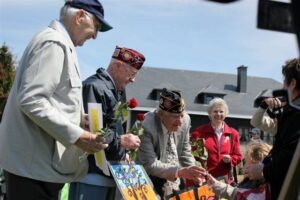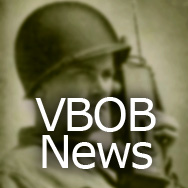2-20 May 2012 Re-visit the Battlefield.
I know, here I am making that last trip again. You all know how it is, the years creep up, and one just doesn’t do all those things one did without thinking twice. Well, it happened this way. This fellow, who is a friend of John Gatens, wanted to travel to Europe in the area where the 106th saw action during the Battle of the Bulge. I now introduce you to Tim Blixt and wife, Lori, who are also members of the 106th Association and VBOB. Tim especially wanted to make a tour with John G., and me, along to talk about where we had been during the battle. Tim had discovered MilSpec Tours and contacted their guide, Patrick Hinchy.
Patrick was experienced with guiding tours though the area of the Ardennes and Schnee Eifel and there was interest with enough people to make up a group for a tour. Also, we were to have the company of Doug Mitchell, an American living in Grosslangenfeld, and, a member of the 106th Association. Doug is a photo-journalist and would accompany us on the tour for documenting our experience. All of this sounded good, especially since my three kids and a grandson chimed in and said that they were interested. So, nobody had to hold a gun on me to get me to sign us up. I was committed. It was a rare and special opportunity for us to meet again with those folks that I now consider an extended family. There is no substitute for being there.
Among those to sign up are a few familiar names to our Association. John Swett came with two daughters and a grandson. Barney Mayrsohn was with us for a few days with his friend from Paris, Jacques Klein. We had three gentlemen with us who are old friends and live in my neighborhood. Their interest was in the history of the battle. Wayne Dunn’s father was Captain Thomas Dunn, Company Commander of 423/H. The other two were Bob Mullauer and Frank Armiger, both military historians and friends as well. All of us have been living the good life and, except for those who had lost family and friends during the war, had probably not given much thought about life in Europe then and now. Twenty-two were signed up for the whole week, plus Barney and Jacques for two days.
The flight to Brussels was uneventful for me. That’s the way I like flying, no surprises. Flying all night and arriving early the next day is a bit trying, but one can adapt. The weather in Brussels was sunny, but rather cool. Warm clothing was needed. So, after getting established in the Novotel Hotel, most of the tour group used public transportation into downtown Brussels to sight see the old city.
Next day, Monday 14th, we boarded our bus for the first real day of the tour. The first stop was at Thimister-Clermont to visit the “Remember ‘39-‘45 Museum.” We were warmly welcomed by the owners/curators, Mathilda and Marcel Schmetz. They are now old friends to some of us. Hugs and kisses were in order. We were seated at long tables and Mathilda related what had happened there while under Nazi control and how the museum came about after the end of the war. She then treated us to a nice lunch before guiding us through the museum. The collection of items is always permanent with M&M. They never give up anything that has been given to them or that they have collected from the veterans. The U. S. !st Infantry Division fought in this area and some of the items here are those left behind when that division moved on. Many items have been donated since by 106th Division, and other, veterans who have visited the museum. Marcel is a master mechanic and artist and has constructed the dioramas and exhibits himself. His latest contributions are a full scale M-10 Tank Destroyer and a full scale V-1 Buzz Bomb. Even a close inspection does not reveal that they are made of wood.
All American veterans who visit the museum are honored with their own memorabilia by leaving their name on the side(s) of a Red Ball Express semi-truck and photos made when in uniform for display. The very uniform that John Swett wore neatly dressed a manikin. Donations of any WW II items from veterans are always welcome as well. We didn’t have enough time here. Of course, we never do.
We departed our friends, M&M, and drove next to Henri Chapelle American Military Cemetery. At the cemetery we were greeted by the Superintendent, Bobby Bell, and his staff. The U. S. Air Force Color Guard under the leadership of SSGT. Estupinan from Spangdahlem AFB were also there waiting for us to participate. They were sharp! Arrangements had been made for supplying us with a wreath for the monument honoring all who rest there and a special flower arrangement for the grave of 1st Lt. Eric F. Wood, Jr.
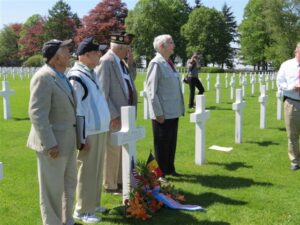 We 589th veterans gave homage to our lieutenant who we consider a genuine hero. Also we made a visit to the grave of Captain James L. Manning who was Barney Mayrsohn’s C. O., and paid our respects there. While at the grave sites we were apparently observed by two USAF A-10 “Wart Hog” attack airplanes from the Air Base. They circled around us twice at low level and then flew off wagging their wings. It is my feelings that it is something they do spontaneously when ever they observe people in the cemetery. Also at the cemetery was our Belgian friends, Denise Oger and Anne-Marie Noel-Simon from CRIBA, and a USAF photographer and reporter team from the news media at Spangdahlem AFB.
We 589th veterans gave homage to our lieutenant who we consider a genuine hero. Also we made a visit to the grave of Captain James L. Manning who was Barney Mayrsohn’s C. O., and paid our respects there. While at the grave sites we were apparently observed by two USAF A-10 “Wart Hog” attack airplanes from the Air Base. They circled around us twice at low level and then flew off wagging their wings. It is my feelings that it is something they do spontaneously when ever they observe people in the cemetery. Also at the cemetery was our Belgian friends, Denise Oger and Anne-Marie Noel-Simon from CRIBA, and a USAF photographer and reporter team from the news media at Spangdahlem AFB.
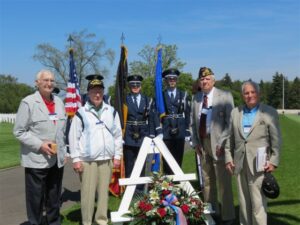 It is always a solemn experience to visit the cemetery, but also it is something that we are drawn to do. There are 7,992 graves in Hemri Chapelle Cemetery, five are those of men of the 589th FAB; MSGT Preston Hill, Pvt. Kenneth H. Garrett, !st Lt Eric F. Wood, Jr., Pvt. Wallace Godwin, and Capt. Malcolm H. Rockwell.
It is always a solemn experience to visit the cemetery, but also it is something that we are drawn to do. There are 7,992 graves in Hemri Chapelle Cemetery, five are those of men of the 589th FAB; MSGT Preston Hill, Pvt. Kenneth H. Garrett, !st Lt Eric F. Wood, Jr., Pvt. Wallace Godwin, and Capt. Malcolm H. Rockwell.
The weather was clear and cool and our first-timers had an opportunity to observe from the bus what a lovely countryside Belgium has. That evening we arrived in one of the oldest cities in Europe, Aachen. In 1944 this was the first major city in Germany to fall to the Allies after bitter fighting. Here is where we spent the night at the Hotel Mercure Aachen Europaplatz..
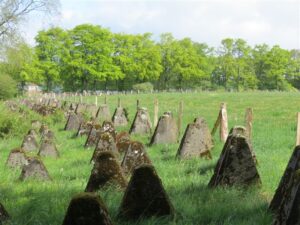 Tuesday May 15 our bus carried us southward through the border country where the Sixth Panzer Army attacked on December 16th. The route followed inside the Westwall, as Hitler named it, or, later referred to as The Siegfried Line. We were able to dismount from the bus and inspect the “Dragon’s Teeth,” close up and appreciate what a formidable obstacle it was for armor and vehicles to cross. However once the enemy was driven from the area tanks fitted with bulldozer blades covered them over. This defensive border extended from Holland in the north to Switzerland in the south and was reinforced with bunkers at strategic points all along the route, about 400 miles.
Tuesday May 15 our bus carried us southward through the border country where the Sixth Panzer Army attacked on December 16th. The route followed inside the Westwall, as Hitler named it, or, later referred to as The Siegfried Line. We were able to dismount from the bus and inspect the “Dragon’s Teeth,” close up and appreciate what a formidable obstacle it was for armor and vehicles to cross. However once the enemy was driven from the area tanks fitted with bulldozer blades covered them over. This defensive border extended from Holland in the north to Switzerland in the south and was reinforced with bunkers at strategic points all along the route, about 400 miles.
The Sixth Panzer Army’s opening offensive was in the front south from Aachen. We traveled down the line of the Westwall past Monschau, Camp Elsenborn, Bullingen, Malmedy, and St. Vith to Clervaux.
The route to Clervaux is picturesque, to say the least. It seems that we are usually following a ridge line that affords a panoramic view on both sides of the road. The villages and towns we pass through are just as shown in the tourist brochures. They all appear to be ancient, but in areas where they were fought over most buildings are no more than about 65 years old. When re-built, the original plans and designs were followed, at least on the outside. Centuries ago most every town grew up surrounding a castle. Many of these old disintegrating structures are now being restored. Some will be tourist attractions and/or B & Bs. In any case they are interesting to view as a way of life that is now ancient history.
Traveling southward still we come to the region that was attacked by the German Fifth Panzer Army. The lines here were thinly defended by the 99th Infantry Division on the north flank, the 14th Cavalry Group between them and the 106th Infantry Division, and on the southern flank the 28th Division was in place. The front extended about 60 miles. This area was considered by higher headquarters as a “quiet front” where nothing happened or was expected to happen. Therefore these units were spread exceptionally thin and some places were not defended at all. Looking at it today in beautiful weather and fully restored it is hard to visualize what happen here in the winter of 1944-45.
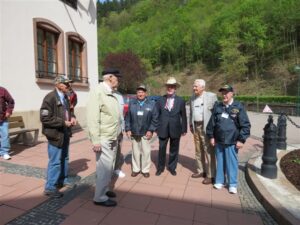 We arrived at Clervaux, Luxembourg, mid afternoon, a town that I have visited several times. It too was devastated during the battle. After registering at the Hotel International we all assembled at the square near The Statue of the GI where we were officially greeted by the President of CEBA, Camille Kohn. We heard a very nice welcoming speech, performed a wreath laying ceremony at the statue, and then moved off into the old castle. Once inside we were ushered into a large conference room where M. Kohn explained the situation of Luxembourg during occupation by the Nazis and the hard fought battle that took place there. That was followed by wine all around and toasts to the Liberators.
We arrived at Clervaux, Luxembourg, mid afternoon, a town that I have visited several times. It too was devastated during the battle. After registering at the Hotel International we all assembled at the square near The Statue of the GI where we were officially greeted by the President of CEBA, Camille Kohn. We heard a very nice welcoming speech, performed a wreath laying ceremony at the statue, and then moved off into the old castle. Once inside we were ushered into a large conference room where M. Kohn explained the situation of Luxembourg during occupation by the Nazis and the hard fought battle that took place there. That was followed by wine all around and toasts to the Liberators.
The castle was severely damaged during the fighting but has been painstakingly restored to its former glory. The castle now houses two museums, one dedicated to the actions of WW II and the other to the Ages of Man. Both are administered by the town ‘fathers.’ We then had the opportunity to browse through the WW II Museum and examine the many artifacts and displays dedicated to the memory of all those who fought for liberty in Luxembourg. Until he passed away in March 2012, Frank Kieffer was the prime collector and curator of this WW II Museum. He will be missed by many of us who knew him personally. Our dinner was presented about 7:30 at the Hotel International. A real pleasant surprise was to find Bernadette Lejeune with us. Bernadette is that special person who manages the Auberge du Carrefour at Baraque de Fraiture. She is most generous with her treatment of the 106th Division veterans who visit there. More about Bernadette and her family later.
Wednesday, May 16th was another cool day and we expected to cover the area occupied by elements of the 106th Division when the attack by the Fifth Panzer Army occurred. Those were the first of many critical days to follow. We stayed on the road but made stops where we could point out positions where various units were on the 16th and pin point locations of the 589th Artillery Batteries. As best we could, John Gatens and I talked about our first experience under fire at a place known as Herzfenn. If one would scan the ground here with a metal detector he would not be strong enough to carry away all of the shell fragments he would discover. We were able to point out the approximate locations where the Germans accepted the surrender of most of two regiments of the 106th after they were caught in a pincer without resupply or means to carry on the fight.
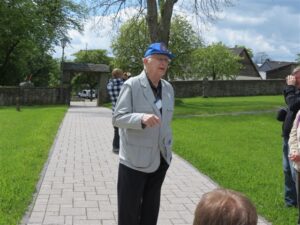 We drove to the town of Bleialf, not very far (,by bus,) where many of the American prisoners spent a day and night herded into the church courtyard. John Swett was one, and he described his experience here to the group. The Hotel Waldblick in Bleialf expected us for lunch and it was only walking distance from the church.
We drove to the town of Bleialf, not very far (,by bus,) where many of the American prisoners spent a day and night herded into the church courtyard. John Swett was one, and he described his experience here to the group. The Hotel Waldblick in Bleialf expected us for lunch and it was only walking distance from the church.
I was very pleased to find a good friend there, Ed Lapotsky, who lives in Germany. Ed is ex-82nd AB Division and very active in several veteran organizations. We became acquainted with Ed some years ago on other trips and have also met in the States on special occasions. Before we parted Ed presented me with a bottle of fine Mosel wine and a challenge coin honoring the C-47 Club of the 82nd AB Association.) After our lunch at the hotel we visited Grosslangenfeld, home the Reusch family and our friend and companion for the tour, Doug Mitchell. We had the opportunity to meet Doug’s wife, Anita, who served up dessert for the group, a delicious apple cake that was made by her mother. It is a shame everyone didn’t get a piece. We then walked a short distance to the village church where there is a monument dedicated to both the German and American soldiers who fought over the village during those days of December 1944. (See The Cub issue Vol 61, No 2, Jan-Mar 2005) The church, which is centuries old, was opened up for our inspection as well. Everyone had a chance to go inside and look around.
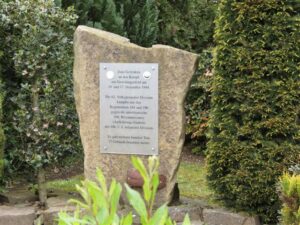 We also examined the monument erected in memory of the bitter fighting that occurred here between the 106th Division Reconnaissance Troop and the German 62nd Volksgrenadier Division. The Germans suffered heavy losses and took the town only after the Americans ran out of ammunition and pulled out.
We also examined the monument erected in memory of the bitter fighting that occurred here between the 106th Division Reconnaissance Troop and the German 62nd Volksgrenadier Division. The Germans suffered heavy losses and took the town only after the Americans ran out of ammunition and pulled out.
We visited the memorial at Wereth, a place where another atrocity occurred during the 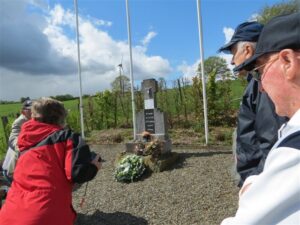 battle. Anne-Marie and Denise were there to provide an orientation of what happened to eleven soldiers from the 333rd Field Artillery Bn. when they sought refuge in one of the local houses. They were soon discovered by the advancing Nazi troops, herded outside to the road and brutally murdered. A monument dedicated in 2004 marks the spot where this happened. We then proceeded to St.Vith for a ceremony of remembrance at the 106th Infantry Division
battle. Anne-Marie and Denise were there to provide an orientation of what happened to eleven soldiers from the 333rd Field Artillery Bn. when they sought refuge in one of the local houses. They were soon discovered by the advancing Nazi troops, herded outside to the road and brutally murdered. A monument dedicated in 2004 marks the spot where this happened. We then proceeded to St.Vith for a ceremony of remembrance at the 106th Infantry Division 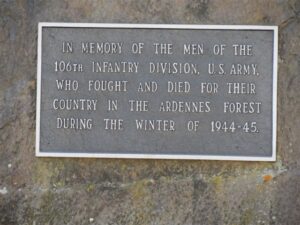 Memorial. The USAF Color Guard under T/Sgt Williams was already there in place along with veterans of the Belgian Fusiliers with their unit flags. The Mayor of St. Vith, Christian Krings, was there to provide an official welcome and deliver a nice speech honoring the 106th Division. We veterans once again presented a wreath at the monument. After the ceremony we assembled in the dining room of the Hotel Pip Margraf for refreshments and social
Memorial. The USAF Color Guard under T/Sgt Williams was already there in place along with veterans of the Belgian Fusiliers with their unit flags. The Mayor of St. Vith, Christian Krings, was there to provide an official welcome and deliver a nice speech honoring the 106th Division. We veterans once again presented a wreath at the monument. After the ceremony we assembled in the dining room of the Hotel Pip Margraf for refreshments and social 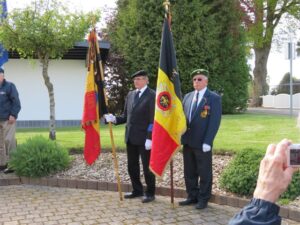 time. On leaving St. Vith we visited through some of those villages whose names would be familiar; Winterspelt, Berg Reuland, Spineux, Ennal, etc. There is never enough time to go everywhere and see everything.
time. On leaving St. Vith we visited through some of those villages whose names would be familiar; Winterspelt, Berg Reuland, Spineux, Ennal, etc. There is never enough time to go everywhere and see everything.
Thursday ,May 17 we drove from Clervaux to Manhay for a mid-morning reception. Our dear friends of CRIBA, Eddy, Bernadette, Anne, Henri, Jacques, Albert, and too many more to mention where there to greet us with something special. When we drove up and saw four US Army Jeeps and one 3/4 ton 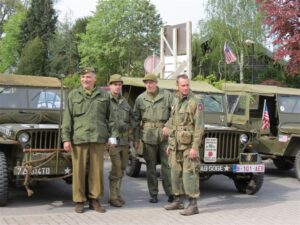 Weapons Carrier parked in front and re-enactors in U.S. uniforms we knew then it had to be special. We were ushered into the Community Hall of Manhay for another welcoming speech by the Bourgemestre, Elie Deblire, and presented with gifts including the Coat of Arms of Manhay and a certificate declaring we three veterans as Honorary Citizens of the Commune of Vielsalm. It was another delightful time to meet again with our friends and be so honored. We remember that the honor is accepted on behalf of all GI’s who were not with us on this day.
Weapons Carrier parked in front and re-enactors in U.S. uniforms we knew then it had to be special. We were ushered into the Community Hall of Manhay for another welcoming speech by the Bourgemestre, Elie Deblire, and presented with gifts including the Coat of Arms of Manhay and a certificate declaring we three veterans as Honorary Citizens of the Commune of Vielsalm. It was another delightful time to meet again with our friends and be so honored. We remember that the honor is accepted on behalf of all GI’s who were not with us on this day.
When we departed Manhay we vets accepted rides in the Jeeps. Our convoy drove to Grandmenil with sirens blaring, declaring, “The Yanks are back!!”
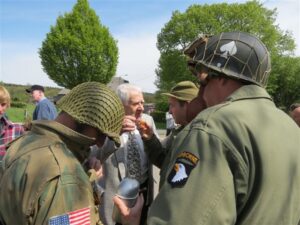 At Grandmenil we stopped and dismounted to inspect the Panzer Mark V Panther tank that is installed on a concrete pad for display. Except for the tracks being damaged it looks to be in fairly good shape. Returning to our Jeeps again we headed back down the road toward Baraque de Fraiture, making a brief stop along the way to inspect another monument. While dismounted, one of the re-enactors produced a canteen and passed around some
At Grandmenil we stopped and dismounted to inspect the Panzer Mark V Panther tank that is installed on a concrete pad for display. Except for the tracks being damaged it looks to be in fairly good shape. Returning to our Jeeps again we headed back down the road toward Baraque de Fraiture, making a brief stop along the way to inspect another monument. While dismounted, one of the re-enactors produced a canteen and passed around some 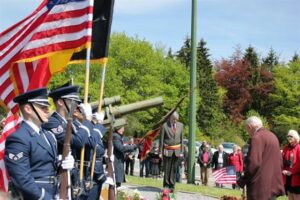 small cups to a few of us older guys. He carefully poured each of us something that didn’t look like water, didn’t smell like water, but, after toasting each other, we found out it didn’t taste like water. So, just to make sure, we toasted the Jeeps, and all present. Thus fortified, we got back on the road and drove the rest of the way to Baraque de Fraiture. Upon our arrival at the crossroads we found that another crowd had assembled to greet us. Again, the USAF Color Guard, this time under S/Sgt Paul, was present.
small cups to a few of us older guys. He carefully poured each of us something that didn’t look like water, didn’t smell like water, but, after toasting each other, we found out it didn’t taste like water. So, just to make sure, we toasted the Jeeps, and all present. Thus fortified, we got back on the road and drove the rest of the way to Baraque de Fraiture. Upon our arrival at the crossroads we found that another crowd had assembled to greet us. Again, the USAF Color Guard, this time under S/Sgt Paul, was present.
We three “Johns” were again greeted by the local officials, participated in a memorial ceremony at the site of the 105mm Howitzer, and were presented with gifts, and honored once again. We all then went inside the Auberge du Carrefour to a lavish sit-down luncheon. The food and wine was excellent as always and we were catered to by 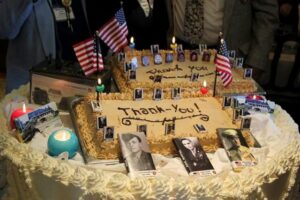 Bernadette’s able staff just like it was going to be our “last meal.” It was like a family reunion with our friends from all around the Ardennes area. Later around 6:30 the tour left the Crossroads to visit Bastogne and the Mardasson Monument that honors all American units that were involved in the Battle of the Bulge. Bernadette and Denise and Anne-Noel insisted that John Gatens, me, and our families stay at the Auberge. “Don’t worry,” they said. “We will get you back to your hotel later.” So, we stayed and watched the bus depart. No problem, more food and wine were put before us until we couldn’t eat of drink any more. We were their honored company until about 10:00 PM when they put us in a taxi and sent us off into the night to Clervaux. Bastogne will have to wait until next time for us.
Bernadette’s able staff just like it was going to be our “last meal.” It was like a family reunion with our friends from all around the Ardennes area. Later around 6:30 the tour left the Crossroads to visit Bastogne and the Mardasson Monument that honors all American units that were involved in the Battle of the Bulge. Bernadette and Denise and Anne-Noel insisted that John Gatens, me, and our families stay at the Auberge. “Don’t worry,” they said. “We will get you back to your hotel later.” So, we stayed and watched the bus depart. No problem, more food and wine were put before us until we couldn’t eat of drink any more. We were their honored company until about 10:00 PM when they put us in a taxi and sent us off into the night to Clervaux. Bastogne will have to wait until next time for us.
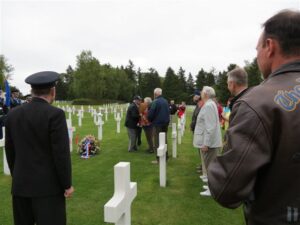 Friday May 18, 2012 Our tour guide, Patrick, arranged for us to travel to the American Military Cemetery (Hamm) in Luxembourg City. Again we performed a wreath laying ceremony accompanied by the USAF Color Guard and also members of the organization known as U. S. Veterans Friends, Luxembourg A.S.B.L. One of our tour members, a war orphan, was Vicki Cool whose father, Pvt. Victor LaCount, was buried at this cemetery. We attended a service at his grave where again, flowers were placed and a notice hung on the marble cross indicating that the family had visited. Here is where the three veterans of the 106th
Friday May 18, 2012 Our tour guide, Patrick, arranged for us to travel to the American Military Cemetery (Hamm) in Luxembourg City. Again we performed a wreath laying ceremony accompanied by the USAF Color Guard and also members of the organization known as U. S. Veterans Friends, Luxembourg A.S.B.L. One of our tour members, a war orphan, was Vicki Cool whose father, Pvt. Victor LaCount, was buried at this cemetery. We attended a service at his grave where again, flowers were placed and a notice hung on the marble cross indicating that the family had visited. Here is where the three veterans of the 106th 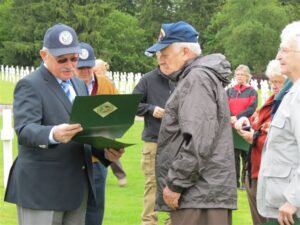 Infantry Division were presented with certificates recognizing us with the Medal of Honor and a medal to go with it. The presentation was made by Constant Goergen, Honorary President of the above organization. The tour group also visited the grave of General George S. Patton where the cemetery superintendent delivered a moving speech of the life of General Patton and how much his memory is revered in Luxembourg. We made a noon-time stop in downtown Luxembourg City for a light lunch and walk around. It is a fascinating city and I would like to spend more time there (As a side note, English is spoken most places in Europe so a tourist can get about with confidence.)
Infantry Division were presented with certificates recognizing us with the Medal of Honor and a medal to go with it. The presentation was made by Constant Goergen, Honorary President of the above organization. The tour group also visited the grave of General George S. Patton where the cemetery superintendent delivered a moving speech of the life of General Patton and how much his memory is revered in Luxembourg. We made a noon-time stop in downtown Luxembourg City for a light lunch and walk around. It is a fascinating city and I would like to spend more time there (As a side note, English is spoken most places in Europe so a tourist can get about with confidence.)
The next stop on our tour was the huge Military Museum in Diekirch administered by Roland Gaul. This is certainly one, if not the, largest collections of military materials used during WW II in Europe. We spent the rest of the afternoon absorbing more information than we could possibly remember about life in the opposing armies. Mr. Gaul gave a few of us a quick look inside the library of several thousands of books written about WW II. Our timing placed us back in Clervaux in time to freshen up for another great dinner at the Hotel International. We were pleasantly surprised to find our old friend, Vincent Gerard, and his mother, Anne, waiting for our arrival. Vince has been a gracious host to many visiting veterans in past years. It was nice to reminisce of past visits to the battlefield with Vince.
Saturday 19 May was our final day together. We departed Clervaux following as close as was practical the route taken by the American POW’s on their trek to a prison camp. They marched from Auw, Bleialf, Pruem, and other places in the area to Gerolstein. Gerolstein 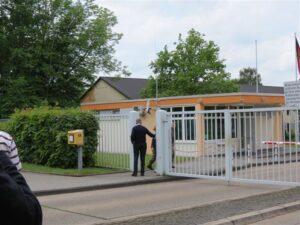 was a rail junction and a place where some POW’s were jammed into 40 & 8 boxcars and others were marched off, walking to their destinations, sometimes several hundred miles. Many made their next “home” at Stalag XII-A in Diez, near Limburg, Germany. Our guide, Patrick, directed the driver and we found what we were looking for. This was where Stalag XII-A once was, but today there is no trace of it. Instead there is a German Army base. Of course, it is fenced in with a formidable gate blocking the entrance. Patrick beckoned to the guard on duty and after explaining that we had ex-pow’s on board and that this site was once their prison, the guard agreed to conduct us on a brief tour of the base. Yes, there is absolutely no trace of a prison camp. On passing through the gate again to leave we received a snappy salute from the sentry. Nice finish. We hit the road again for Frankfurt and our last night in the Sheraton Hotel, actually in the confines of the huge Frankfurt Airport.
was a rail junction and a place where some POW’s were jammed into 40 & 8 boxcars and others were marched off, walking to their destinations, sometimes several hundred miles. Many made their next “home” at Stalag XII-A in Diez, near Limburg, Germany. Our guide, Patrick, directed the driver and we found what we were looking for. This was where Stalag XII-A once was, but today there is no trace of it. Instead there is a German Army base. Of course, it is fenced in with a formidable gate blocking the entrance. Patrick beckoned to the guard on duty and after explaining that we had ex-pow’s on board and that this site was once their prison, the guard agreed to conduct us on a brief tour of the base. Yes, there is absolutely no trace of a prison camp. On passing through the gate again to leave we received a snappy salute from the sentry. Nice finish. We hit the road again for Frankfurt and our last night in the Sheraton Hotel, actually in the confines of the huge Frankfurt Airport.
Patrick had intended to tour us through the old city but we were diverted by police. Later we found out that the center of Frankfurt was jammed by a several thousand person ‘Occupy” group. It seems that they had shut down downtown traffic. We proceeded to the airport instead. Our accommodations were in walking distance to the United Airlines Check-in. This is a really large facility housing not only the airport but all brands of hotels, eating places, and shops. We found a nice German style restaurant and settled for a schnitzel, what else?
And so, as the sun slowly settles in the west we prepare for our flight the next day. It has been a fast week. There were no drop outs, and we did all that we set out to do and much more. The plane rides are long and boring, but that is a part of going anywhere. It beats what ever is second best.
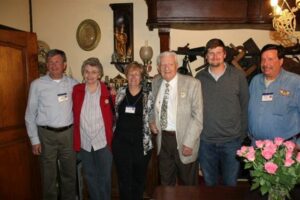 Thanks are beyond just, “Thanks,” and go to our very capable guide, Patrick Hinchy, who made all of our arrangements for us, our driver, Joorg, who safely delivered us through traffic and narrow streets that must have been a bus driver’s nightmare, and Doug Mitchell, who provided much information about the region we traveled and documented our journey. It was a great group to travel with, everyone was compatible and friendly. Our great friends in Belgium, Luxembourg, and Germany were so gracious and entertained us to the nth degree. I hope that it will be possible to do it again.
Thanks are beyond just, “Thanks,” and go to our very capable guide, Patrick Hinchy, who made all of our arrangements for us, our driver, Joorg, who safely delivered us through traffic and narrow streets that must have been a bus driver’s nightmare, and Doug Mitchell, who provided much information about the region we traveled and documented our journey. It was a great group to travel with, everyone was compatible and friendly. Our great friends in Belgium, Luxembourg, and Germany were so gracious and entertained us to the nth degree. I hope that it will be possible to do it again.
